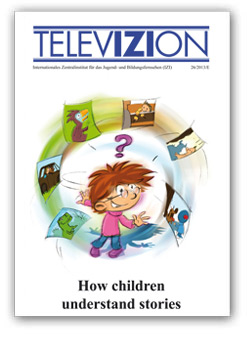|
 >> Overview TelevIZIon >> Overview TelevIZIon
EDITORIAL
Stories create community, provide horizons of meaning, thematize rules and conceptualize utopias (Wulff). For children in particular, they represent an attractive way of engaging with themes and morality, and of seeing a reflection of their own emotional worlds. One of the most famous classic treatises on children’s media thus argues: “Children need fairy tales” (summarized by vom Orde). Rarely, however, have studies examined how children understand the details of stories from children’s TV. Do they “read” the audiovisual texts in the way that adults intend them? Findings from an international study show how apparently unambiguous scenes and images are interpreted in different ways by children (Götz et al.). Text comprehension is an active, constructive process, in which individual elements are assembled into meaningful connections in our minds (Nieding). It is not always easy for adults to comprehend how children understand programmes, especially when difficult themes are involved, such as, in the programme The Little Boy and the Beast, divorce (Holler). Often children get more out of attractively made stories than adults imagine, e.g. in the programme Dino Dan (Holler/Götz). It is precisely the child’s perspective, however, which is the basic prerequisite for continuing to offer attractive and beneficial storytelling for children in the future.
This issue of TelevIZIon will summarize which traditions currently take centre stage in different regions of the world and countries or businesses (Gerhardt) and production companies with high aspirations and potential for creativity (Johnson/Simms, Selig), as well as the potential of new paths in interactive media (Huang/Davison/Jewell/Dockrill) or of technical developments such as 3D stereoscopic technology (Götz/Bulla, Maier).
Maya Götz
Head of the International Central Institute for Youth and Educational Television
RESEARCH
Hans J. Wulff
“Life is made up of stories”
The author highlights the importance of stories in children’s everyday life, and shows which “models of reality” they contain. Insights from narratology and scriptwriting help further our understanding of how good stories come into being.
Maya Götz/Judith Schwarz/
Simone Gruber/Nilüfer Pembecioglu/
Ekatarina Bondarenko/Seham Nasser/
Beth Carmona/Pablo Ramos Rivero
“Why is he running?”
A study involving 300 preschool children from Russia, Turkey, Cuba, Egypt, Germany and Brazil investigated by one-on-one interviews how 3- to 6-yearold children understand 2 short quality TV programmes, The Boy, the Slum and the Pan Lids from Brazil and The Olive Branch from the USA.
Maya Götz/Christine Bulla
“As if you’re right in the middle of
the place where the story is happening”
An IZI study with 51 children and adolescents in Germany inquired how children experience stereoscopic 3D technology, and what expectations they bring to films with this technology.
PROGRAMME RESEARCH
Andrea Holler
When adults have other things
on their minds
In an IZI study, 50 German 3- to 11-yearolds were questioned about the awardwinning quality programme The Little Boy and the Beast. The aim was to find out how they experience the animation, how they understand the story, and whether they see the film as suitable for children.
Andrea Holler/Maya Götz
I like Dino Dan “because it was pure
fantasy”
An IZI study with 59 preschool children in Germany considered the question how children understand the TV series Dino Dan, and what knowledge and attitudes towards research they take from it.
Veronika Geiger
Can children passionately feel with a
little snail?
An IZI study with 97 children from 6 countries investigated to what extent children engage in the intended interpretation of the Swedish clip The Lucky Snail, and whether they get emotionally involved.
EXPERT DISCUSSION
Eric Huang/John Davison/Will Jewell/
Laura Dockrill
Storytelling in interactive media
How will storytelling have to change to fit in with children’s media consumption? Will stories cease to have a beginning, a middle and an end? Directors and scriptwriters discussed in a panel at the Children’s Media Conference 2012 (CMC) in Sheffield about what storytelling for interactive media really means and what future developments they anticipate.
Bernadette O’Mahony/Firdoze Bulbulia/
Hitoshi Furukawa/David Kleeman/
Alejandro Escobar/Firas Dehni/Preben
Vridstoft/Arild Halvorsen/Nils Stokke/
Margret Albers
International views on storytelling
Children’s TV experts all over the world were asked about storytelling in children’s television in their country. Experts from Australia, Africa, Asia, North and South America and Europe responded to 3 questions.
INFORMATION
Heike vom Orde
Children need fairy tales
INTERVIEW
A conversation with Gerhild Nieding
How do preschool children
understand stories?
A conversation with Josh Selig
“It’s a great privilege to make
content for this audience”
A conversation with Ralf Gerhardt
“Stories introduce new experiences”
A conversation with J.J. Johnson and
Christin Simms
Dino Dan: “Creating excitement for
the world”
A conversation with Florian Maier
“There’s an unbelievable amount
of potential in 3D”
INTERNATIONAL EXPERTS' OPINIONS
Open Story
The Little Boy and the Beast
Small Potatoes
Two and a Half Heroes
|




